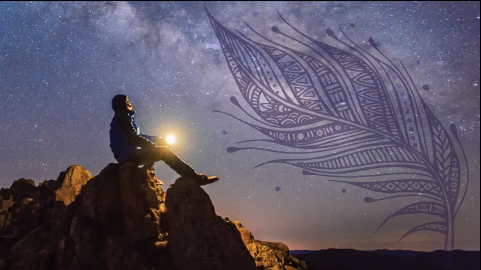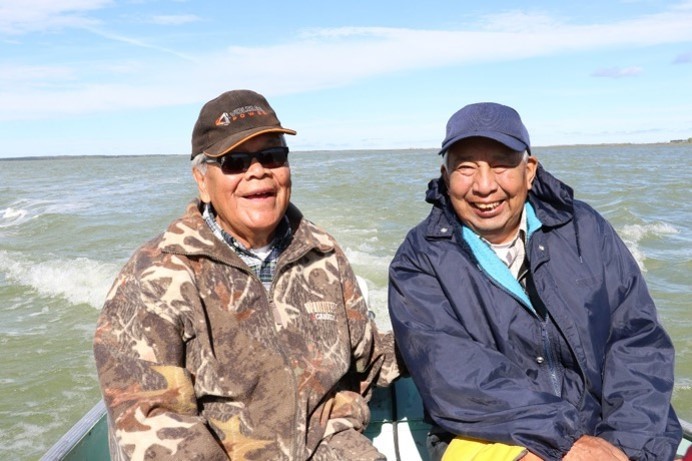Indigenous science

Indigenous science is a distinct, time-tested, and methodological knowledge system that can enhance and complement western science. Indigenous science is about the knowledge of the environment and knowledge of the ecosystem that Indigenous Peoples have. It is the knowledge of survival since time immemorial and includes multiple systems of knowledge(s) such as the knowledge of plants, the weather, animal behavior and patterns, birds, and water among others.
Environment and Climate Change Canada’s Indigenous Science Division
The Indigenous Science Division (ISD) at Environment and Climate Change Canada (ECCC) is an Indigenous-led division created in January 2022 to advance reconciliation in ECCC’s science and research activities.
The mandate of this team is to bridge, braid, and weave Indigenous science with western science approaches to inform and enhance decision-making. These efforts are guided by the importance of Indigenous science indicators and perspectives such as Repatriation, Reconciliation, Renewal, Respect, Reciprocity, Responsibility and Relationships.
The specific objective of the division is to develop and apply an Indigenous lens to ECCC’s science, policy, and program activities.
Transcript
DR. MYRLE BALLARD (Chief Indigenous Science Advisor, Environment and Climate Change Canada):
We have to be the voice of the land. That’s the respect we have to give back because the land gives us, so we have to give back. We have to be the voice. It’s not necessarily a philosophy. A philosophy is a Western term, but we have our Indigenous ways of knowing. I am Dr. Myrle Ballard. I’m the Chief Indigenous Science Advisor with Environment and Climate Change Canada.
With Indigenous peoples, it’s the teaching is not in a classroom, like a building where there’s four walls. The teaching comes from the land, comes from Knowledge Holders who share about what’s going on the land. It’s not intentional either. There’s not a specific agenda, there’s not a curriculum to follow, but it’s part of the teaching. It’s an ongoing process. It’s not the forced learning, but it’s a learning to be able to look after yourself. Kipimoojikewinis what we call it. That’s the general life that I have, which is based on the activities that I do. When the mentor, mentee, the Elder, the Knowledge Holder teaches, but it’s not teach per se, it’s a relationship. It’s a doing. It’s an activity. The Indigenous science that Indigenous peoples practice, when I use science, I use it very specifically for a reason. There’s different types of knowledge systems, but in this context, I use science because Indigenous peoples knowledge of the land, it’s about the science of the land. It’s about the science of the water. It’s about the science of the species, the animal species as well.
It’s important that we distinguish the Western ways from the Indigenous ways. When we think of Western, it’s very a siloed approach. And when we think of Western trained scientists, they go through the process of their training in an academic setting. Where there’s labs, and the testing of animals. Indigenous people pass on their knowledge. A Knowledge Holder does not say to the learner, ‘Today I’m going to take you on the land, I’m going to teach you about which way the water flows.’ It’s not like that. It’s the relationship where at the same time they’re being taught to look after themselves and to be able to sustain themselves, that they’re being taught the traditional ways. It’s important that people understand Indigenous worldviews because these are a part of the teachings that will inform the public, in the importance of land. This is really critical because if people in general make an effort to understand that, and then they’ll start to understand Indigenous people’’ concern over land, the loss of land, the degradation of land and why these issues are important to Indigenous people. They know about the land because they grew up on the land, they were part of the land.
I was on the land a lot growing up. And spending the time with the Knowledge Holders and the traditional activities. I went with my mom and my aunt, and we went the scenic route. Now, we didn’t go very far from my mom’s house, that was on the reserve, but because of the loss of land had taken away from the land and being confined to reserve, for my mom and my aunt, that was a big day for them. And we packed a lunch and we took lawn chairs. We were out on the land. We took breaks, we made a fire and then we had lunch. And now, this was all part of the reconnection with the land, because that’s what they grew up with. And that to them, it was a big day being part of the land.
We held a workshop where we invited Indigenous Knowledge Holders to talk about Indigenethics and what Indigenethics is, is about the ethical treatment of what we call the environment, the land, the water, species and including man.
So, they talked about the ethical ways we should treat the land and the differences between the way Western science treats the environment. What we should do to work together, what we shouldn’t do, and the gaps that are there. The way species are managed today, it’s not the same as the traditional ways that that were done before. There’s a lot of reasons why species decline in the population is because of encroachment. We are the encroachers. They were there first, but we are overtaking their natural habitat and we have to think of better ways of solving these kind of problems.
Ethical treatment. We need to come up with better strategies in preserving species and also learning from both of the knowledge systems, the Indigenous science and the Western science. Where they can work together in solving a lot of these issues that are taking place regarding climate change, the loss of biodiversity. The Indigenous peoples, are Knowledge Holders because of the close relationship with the land and the close relationship with the species. They are the voice for that third eye. And that’s why it’s really critical for Indigenous peoples to be the voice, that third eye, the third voice, that’s of the three-eyed seeing approach that I developed. Three-eyed seeing is what we have to do to manage the species around us, that we have to incorporate everything into the conservation and the protection of the lands, the environment and the species that live in there. For those species around us that cannot talk for themselves. Those species that come to us when they’re in trouble, we have to start listening. We have to be the voice for them. And we have to respect them as well.
Other foundational concepts

Knowledge Holders who know how the lake behaves and the characteristics of the lake. In the Indigenous worldview the lake is a living entity. The Knowledge Holders are stewards of this lake.
Bridging is about fostering awareness, understanding, and recognition of Indigenous science as a distinct and equal science to western science approaches. Bridging is accomplished through mutual respect, repatriation, relationship building, engagement activities, and the development of learning resources.
Braiding is about bringing together different ways of knowing and being. For the ISD team, this refers to the braiding of Indigenous science and western science systems to achieve a holistic understanding of the environment through while maintaining the integrity of each knowledge system. Braiding is founded on all of the Indigenous science indicators included in the bridging as well as reciprocity, renewal, and mutual learning and collective benefit(s) of science outcomes.
Weaving is about all of the Indigenous science indicators involved in bridging and braiding as well as the inclusion of self-determined Indigenous methodologies, research paradigms, and worldview. Weaving involves appreciating and applying Indigenous science tools to inform approaches to environmental issues and species management in ways that align with the approaches specified by Indigenous Nations, governments, specific communities and international instruments such as the United Nations Declaration on the Rights of Indigenous Peoples (PDF; 154 kB). Weaving is the path of Reconciliation.

Text description
Graphic built of 3 arrow sections representing the 3 foundational concepts:
- dark green arrow with solid, straight line above a squiggly line representing a “bridge” over water
- dark blue arrow with 2 intertwined lines in a braid representing “braiding”
- light green arrow with 2 lines intertwined representing a “weave”